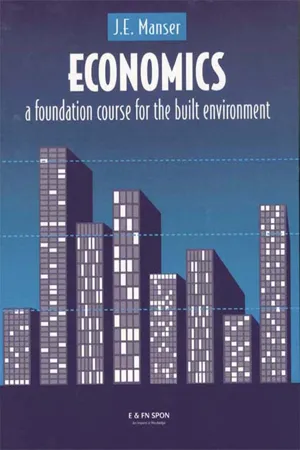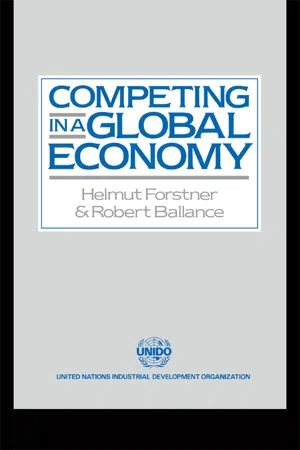Diseconomies of Scale
Diseconomies of scale refer to the situation where the long-run average costs of production increase as a firm expands its output beyond a certain point. This can occur due to inefficiencies in coordination, communication, and management as the organization grows larger. It is the opposite of economies of scale, where average costs decrease as output increases.
8 Key excerpts on "Diseconomies of Scale"
- eBook - ePub
Microeconomics
A Global Text
- Judy Whitehead(Author)
- 2014(Publication Date)
- Routledge(Publisher)
...The signal to producers fearing competition in a newly opened market, for example, is to seek to identify the minimum optimal scale for their industry and attempt to reach this level of output in order to meet any competitive challenges. This assumes that the firms are all using the same technology (managerial, production, etc.) meaning that they are essentially using the same production function. 6.4 Economies of Scale The concept of economies of scale is a long-run phenomenon. These economies of scale are internal to the firm and may arise from increasing the number of plants (plant replication) as well as from increasing plant size. They may also derive from expanding the plant with the same product or by diversifying into other products. Diseconomies of Scale must be considered as well. Internal economies and Diseconomies of Scale should be distinguished from external economies and diseconomies. Whereas internal economies determine the shape of the long-run average cost curve, external economies cause shifts in the position of the long-run average cost curve. External economies and diseconomies are exogenous factors generally outside of the producer’s control, such as the cost of inputs. Economies and Diseconomies of Scale should also be distinguished from economies and diseconomies of scope although there are some interrelationships. Typically, economies of scale are considered to be related to the supply or production side while economies of scope are related to the demand or marketing side and particularly to the bundling of goods for sale. However, in some cases, the promotional or marketing activities are included in the consideration of economies of scale in production...
- eBook - ePub
Economics
A Foundation Course for the Built Environment
- J.E. Manser(Author)
- 2003(Publication Date)
- Routledge(Publisher)
...As the firm moves from SRAC 1 to SRAC 2 it moves to the right, an increase in the volume of output, and downwards, a reduction in average costs of production. This shows an initial benefit from economies of scale —output is rising faster than costs. Then there may be a period of constant returns to scale with output and costs increasing at the same rate, leaving unit costs unchanged. Finally expenditure on costs starts to accelerate, rising faster than output, and Diseconomies of Scale are experienced. Figure 10.1 Short-and long-run average cost curves. ECONOMIES OF SCALE What makes it possible to produce a large volume of goods at less cost per unit than smaller volumes? Many economies of scale are linked to mass production methods, based on division of labour. By dividing work into small tasks, each of which is undertaken by a specialist worker, output can be raised substantially. A classic description is given by Adam Smith, the founding father of economics, in his account of a pin factory: ‘One man draws out the wire, another straightens it, a third cuts it, a fourth points it, a fifth grinds the top to receive the head; to make the head requires two or three distinct operations; to put it on is a peculiar business; to whiten it is another; it is even a trade in itself to put them into paper. The important business of making pins is, in this manner, divided into about 18 distinct operations.’ The outcome of organizing work like this, instead of having each worker making pins from start to finish, is a huge increase in productivity Adam Smith estimated output to be several thousand pins per man, per day, instead of a few dozen. (The reasons for such a staggering increase are worth thinking about. How much scope is there for organizing construction work in this manner? Consider, too, any drawbacks to this system of working, which finds its epitome in the conveyor-belt production line.) Production methods are allied to the technology employed...
- eBook - ePub
Competing in a Global Economy
An Empirical Study on Trade and Specialization
- Robert Ballance, Helmut Forstner(Authors)
- 2003(Publication Date)
- Routledge(Publisher)
...Some support for this impression can be found in both industry-specific studies (e.g. McGee, 1973; Ayler, 1981) and more general investigations (Griliches and Ringstad, 1971). Certainly, improvements in information technology are intended to remove many of the managerial Diseconomies of Scale associated with communications and control in large organizations. It is these types of diseconomies that were traditionally thought to be the main cause of diminishing returns at higher levels of output. A clear picture of the relationships between cost curves and concepts such as economies of scale, economies of scope and technological change cannot be assembled. However, there seem to be grounds to make the (comparatively weak) assertion that the incidence of decreasing returns within the manufacturing sector has been reduced. As a result, the economies-of-scale model poses a serious challenge to the assumption of non-increasing returns which is so firmly embedded in the H–O theory. Such a possibility makes it important to obtain some impression about cross-country patterns of scale economies, however crudely derived. The extent of scale economies can be measured by various methods. Estimates of the MES may be obtained by interviewing engineers or executives, by studying the variation of costs with scale, by relating profitability to the size of plants or firms, or by assuming that some fraction of an industry’s output is produced in efficient plants in a given country. Answers given in interviews may be speculative when the information required goes beyond design decisions, while evidence gathered from real data is subject to competitive conditions and historical circumstances. All these problems are magnified in the case of a cross-country study. Following Hufbauer (1970, pp. 178–9), the present study uses size elasticities of output per person engaged as a proxy for scale economies...
- eBook - ePub
Contemporary Economics
An Applications Approach
- Robert Carbaugh(Author)
- 2016(Publication Date)
- Routledge(Publisher)
...As a firm gets larger and larger, the opportunities to realize economies of scale are eventually exhausted. As a firm grows, it is likely to encounter Diseconomies of Scale, which cause unit cost to increase and the LRATC curve to turn upward. We can trace Diseconomies of Scale to the problems of managing large-scale operations. Beyond some scale of operation, the daily production routine becomes removed from the firm’s top executives as additional layers of bureaucracy are added to the management team. The paperwork burden grows, and managers must control many business activities—finance, transportation, accounting, sales, research and development, personnel, and so on. The red tape and bureaucratic problems of running a large-scale operation contribute to inefficiencies and increased cost per unit. Although Ford Motor Co. benefits from economies of scale, its large size also poses problems. For example, during the 1970s, Ford constructed a factory in Flat Rock, Michigan, to manufacture blocks for 8-cylinder engines. Ford followed the principle that large-scale production brings lower costs per unit of output. The firm spent $200 million to build a 4-story factory designed exclusively to manufacture engine blocks in the fastest, most efficient way possible. By 1981, however, Ford had shut down the factory and shifted production to a much older plant in Cleveland. The reason? The Flat Rock plant was too big and inflexible. It had been constructed to make engines at very large volumes, but it could not be converted to produce the 4- and 6-cylinder engines that became popular as gasoline prices rose. In effect, the Flat Rock plant was viewed as an inefficient dinosaur that could not keep pace with the rapidly changing economy. There may also be an intervening range of output over which a firm realizes constant returns to scale. This occurs when a firm’s output changes by the same percentage as the change in all inputs...
- eBook - ePub
Media Economics
Applying Economics to New and Traditional Media
- Colin Hoskins, Stuart M. McFadyen, Adam Finn(Authors)
- 2004(Publication Date)
- SAGE Publications, Inc(Publisher)
...For example, assembly line production only becomes possible when the firm has achieved a certain size. A firm cannot use half an assembly line or a quarter of a robot. Production of most consumer electronics products would be subject to technical economies. B. Dimensional relations. Capacity (output) of goods like oil tankers and beer vats increases more than external size. The capacity of a concert hall or stadium increases more than proportionally to the size of the parcel of land on which it is built. C. Specialization. Increases in size permit greater specialization of factors of production. Specialization of labor on the factory floor enabled Ford to reduce the time needed to assemble a Model T from 14 hours to 93 minutes. Growth of firm size also facilitates specialization of managerial tasks. For example, suppose Jock runs a one-man desktop publishing business. Although he is very good at the production side of the job, he is poor at dealing with customers and finds this part of the job is taking up considerable time. If he hires Jill, who is experienced and successful in sales and customer relations, this would enable Jock to specialize on the production side. Doubling personnel and, as necessary, equipment could be expected to more than double output. D. Managerial economies. Some managerial functions do not increase in proportion to output. For example, a movie studio that distributes 40 films a year does not need a distribution arm that is twice as big as one distributing 20. A publisher with 100 titles does not need twice the sales staff as a publisher with 50 titles. Similarly, research and development does not usually have to be increased in proportion to output. Decreasing returns to scale apply if an X% increase in all inputs increases output by less than X%. Decreasing returns to scale are also known as Diseconomies of Scale. Problems of coordination and communication are often encountered with larger size...
- eBook - ePub
- Lynne Milgram, M.D., MBA, Alan Spector, Ph.D., M.D., Matt Treger(Authors)
- 2010(Publication Date)
- Routledge(Publisher)
...41 Taking Advantage of Economies of Scale It's probably no surprise to hear that buying products in bulk is often cheaper than purchasing smaller amounts. The same phenomenon underlies the concept of economies of scale, which applies to purchasing, manufacturing, maintenance, and even marketing. Examples of economies of scale include: Lower construction costs for tract homes and planned communities Greater efficiency of production lines Savings when purchasing a “family size” product Discounts offered on larger orders or purchases Economies of scale often provide a distinct competitive advantage for companies. As companies grow, they are able to capitalize on increased volume. For example, suppliers will frequently offer deeper discounts as order sizes increase. Production volume may also justify the purchase of specialized equipment, or vertical integration on the side of suppliers or distributors. The results are lower production costs and the ability to offer a product at a more competitive price. Economies of scale do not happen automatically; they must be actively recognized and pursued by management. Like bulk purchasing, economies of scale can provide savings, but only for the smart shoppers....
- eBook - ePub
- Enrico Colombatto(Author)
- 2016(Publication Date)
- Routledge(Publisher)
...As we noted in Chapter 4, by exploiting economies of scale, producers are able to spread the burden of fixed costs over a larger quantity of output and to take advantage of more efficient techniques. The results are lower average production costs, which under competitive conditions translate into lower prices. For example, consider how much it would cost to produce a TV set or a car if the producer could sell only ten pieces a year to a local market of some 5,000 individuals; and compare this cost with the cost of production associated with a plant producing some 1,000,000 units a year for a market populated by 500 million potential buyers, all looking for the best products at the lowest prices. Of course, lower production costs and lower prices enhance consumers’ purchasing power. But consumers also enjoy a second kind of benefits: those generated by product differentiation. These benefits relate to the fact that each consumer has his own preferences, but most standardised products differ from what each potential consumer perceives as his ideal. Certainly, a producer could acquire market shares by developing a wide range of varieties of a given good, in order to appeal to the tastes of a broad range of consumers. But if the size of the market is limited and economies of scale matter, the production of small quantities for each version involves high average costs, which translate into prices that might be unacceptable to most buyers. For example, although consumers are certainly happy when they can choose among many different types of chairs for their living rooms, they might be unwilling to pay a relatively high price just to have the chair that perfectly matches their dreams and would be happier to settle for a lower-priced chair that comes close to their ideal...
- eBook - ePub
- Bonnie Nguyen, Andrew Wait(Authors)
- 2015(Publication Date)
- Routledge(Publisher)
...For example, a firm’s long-run average total cost curve is the lower envelope of the short-run average total cost curves. In the long run, if a firm’s long-run average cost curve is downward sloping with output, the firm experiences economics of scale. If long-run total costs are rising with output there are Diseconomies of Scale. Finally, a horizontal long-run average total cost curve indicates that there are constant average costs. Notes Short run (and long run) are explicitly in Section 7.2. Moreover, increasing returns to scale is not necessarily incompatible with the short-run notion of diminishing MP. Note that, in the long run, there is only one average cost. We do not need to separate average costs into average fixed cost and average variable cost for the simple reason that there are no fixed costs in the long run. The shape of the long-run average cost curve is determined by returns to scale (discussed earlier in section 7.3.2). That is, if we have increasing returns to scale (whereby output more than doubles when all inputs are doubled) this will have the effect of creating economies of scale (that is, declining long-run average cost). Similarly, if there are decreasing returns to scale, we will have Diseconomies of Scale; if there are constant returns to scale, we will have constant average costs. However, it is important not to conflate ‘economies of scale’ with ‘returns to scale’. The former refers to the relationship between output and cost; the latter refers to the relationship between inputs and output....







